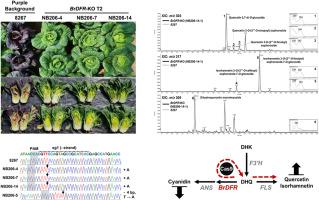通过cas9介导的BrDFR基因敲除重定向紫甘蓝类黄酮通量
IF 5.7
2区 生物学
Q1 PLANT SCIENCES
引用次数: 0
摘要
紫色大白菜(芸苔)的变种。北京人)主要积累以花青素为基础的花青素。虽然二氢黄酮醇4-还原酶(DFR)是花青素生物合成的关键酶,但推定的rapa DFR基因(Bra027457)的功能尚未得到证实。从4个绿色或紫色表型的油菜自交系中分离出Bra027457的编码区并进行测序,未发现序列变异。Bra027457的表达与花青素积累相关,体外实验证实其具有还原三种二氢黄酮醇底物的能力。利用CRISPR/Cas9,我们敲除了紫色系8267中的Bra027457,获得了无转基因、纯合子的BrDFR-KO植株。由于花青素完全丢失,这些基因表现出绿色表型,验证了Bra027457是真正的BrDFR基因。BrDFR-KO头部的代谢物分析显示槲皮素(Q)、异鼠李素(IR)和二氢槲皮素(DHQ)显著增加。LC/MS分析进一步鉴定出5种黄酮醇苷和1种DHQ苷,其中以q3,7 -二- o -葡萄糖苷和IR 3- o -(2 - γ - o -阿魏酰基)槐苷-7- o -葡萄糖苷为主。这些发现有助于我们对芸苔属植物类黄酮生物合成的认识,并为大白菜改良提供了宝贵的遗传资源。本文章由计算机程序翻译,如有差异,请以英文原文为准。

Redirecting flavonoid flux in purple Chinese cabbage via Cas9-mediated BrDFR knockout
Purple varieties of Chinese cabbage (Brassica rapa subsp. pekinensis) predominantly accumulate cyanidin-based anthocyanins. Although dihydroflavonol 4-reductase (DFR) is a key enzyme in anthocyanin biosynthesis, the function of the putative B. rapa DFR gene (Bra027457) remained unverified. We isolated and sequenced the coding region of Bra027457 from four B. rapa inbred lines with either green or purple phenotypes and detected no sequence variation. Bra027457 expression correlated with anthocyanin accumulation, and in vitro assays confirmed its ability to reduce all three dihydroflavonol substrates. Using CRISPR/Cas9, we knocked out Bra027457 in the purple line 8267 and obtained transgene-free, homozygous BrDFR-KO plants. These exhibited a green phenotype due to complete anthocyanin loss, verifying Bra027457 as the authentic BrDFR gene. Metabolite profiling of BrDFR-KO heads revealed significant increases in quercetin (Q), isorhamnetin (IR), and dihydroquercetin (DHQ). LC/MS analysis further identified five flavonol glycosides and one DHQ glycoside, of whch Q 3,7-di-O-glucoside and IR 3-O-(2‴-O-feruloyl)sophoroside-7-O-glucoside were predominant. These findings advance our understanding of flavonoid biosynthesis in Brassica species and provide valuable genetic resources for Chinese cabbage improvement.
求助全文
通过发布文献求助,成功后即可免费获取论文全文。
去求助
来源期刊
CiteScore
11.10
自引率
3.10%
发文量
410
审稿时长
33 days
期刊介绍:
Plant Physiology and Biochemistry publishes original theoretical, experimental and technical contributions in the various fields of plant physiology (biochemistry, physiology, structure, genetics, plant-microbe interactions, etc.) at diverse levels of integration (molecular, subcellular, cellular, organ, whole plant, environmental). Opinions expressed in the journal are the sole responsibility of the authors and publication does not imply the editors'' agreement.
Manuscripts describing molecular-genetic and/or gene expression data that are not integrated with biochemical analysis and/or actual measurements of plant physiological processes are not suitable for PPB. Also "Omics" studies (transcriptomics, proteomics, metabolomics, etc.) reporting descriptive analysis without an element of functional validation assays, will not be considered. Similarly, applied agronomic or phytochemical studies that generate no new, fundamental insights in plant physiological and/or biochemical processes are not suitable for publication in PPB.
Plant Physiology and Biochemistry publishes several types of articles: Reviews, Papers and Short Papers. Articles for Reviews are either invited by the editor or proposed by the authors for the editor''s prior agreement. Reviews should not exceed 40 typewritten pages and Short Papers no more than approximately 8 typewritten pages. The fundamental character of Plant Physiology and Biochemistry remains that of a journal for original results.

 求助内容:
求助内容: 应助结果提醒方式:
应助结果提醒方式:


